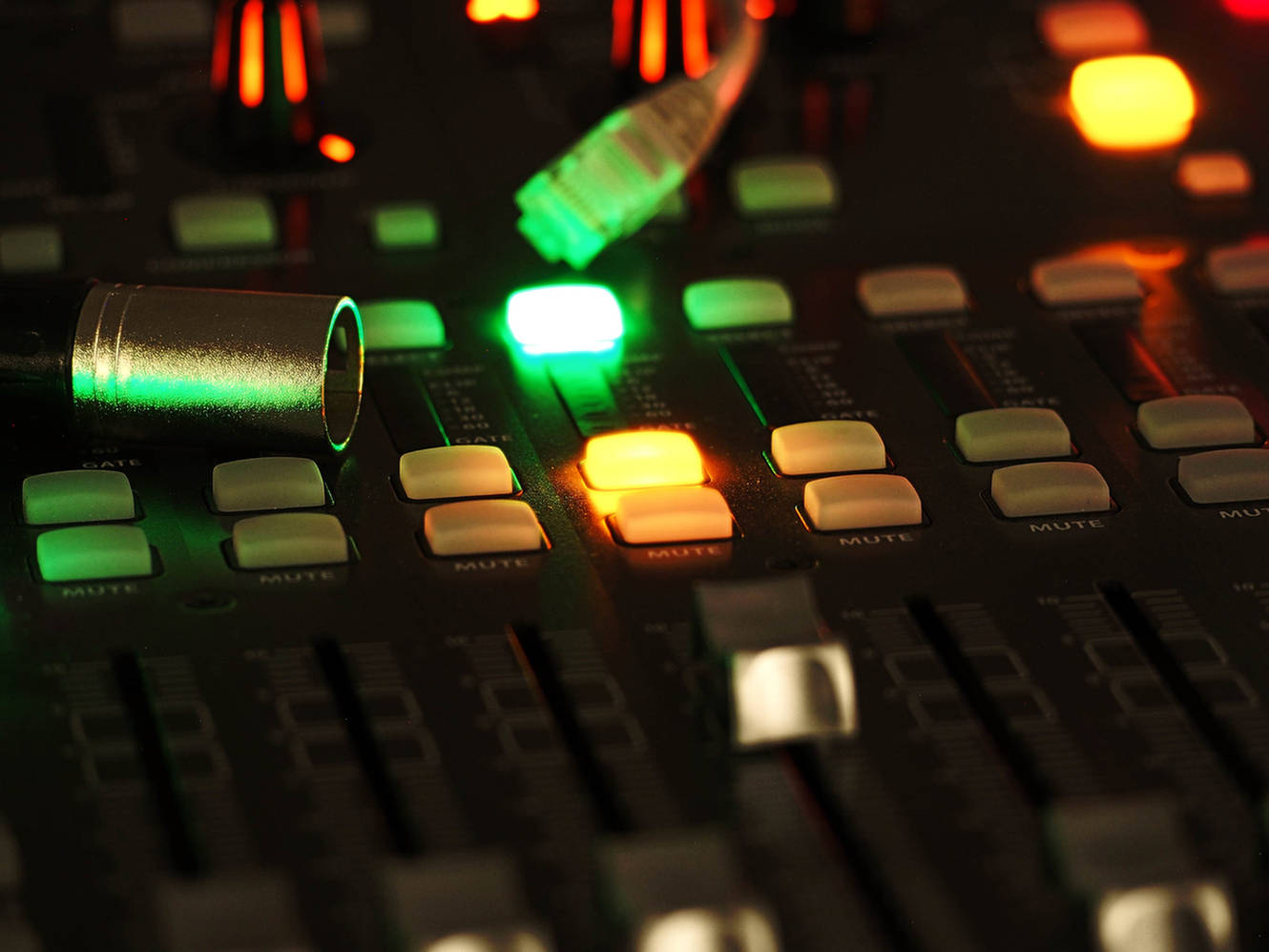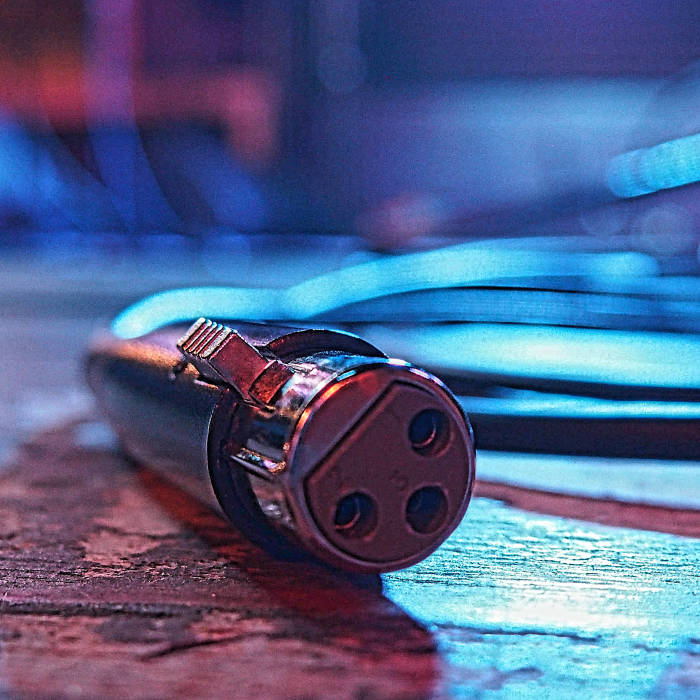This business is all about electricity, but the electricity can mean lots of different things.
Please Remember:
The opinions expressed are mine only. These opinions do not necessarily reflect anybody else’s opinions. I do not own, operate, manage, or represent any band, venue, or company that I talk about, unless explicitly noted.

 Want to use this image for something else? Great! Click it for the link to a high-res or resolution-independent version.
Want to use this image for something else? Great! Click it for the link to a high-res or resolution-independent version.A fader, an XLR cable, and an Ethernet cable walk into a bar.
None of them could have ducked, because cables and faders can’t walk into a bar anyway. Besides, they don’t play nice with liquids, if we were talking about the other kind of bar.
Look, some jokes just don’t work out, okay?
Every object I mentioned above deals with electricity. In the world of audio it’s pretty much all about electricity, or the sound pressure waves that become (or are generated by) electricity. What trips people up, though, is exactly what all those signals actually are. An assumption that’s very, very easy to make is that all electrical connections in the world of audio are carrying audio.
They aren’t.
The Three Categories
In my experience, you can sort electrical signals in the world of audio into three “species:”
- Audio signals.
- Data signals that represent audio.
- Signals that represent control for an audio-processing device.
Knowing which one you actually have, and where you have it, is critical for understanding how any audio system or subsystem functions. (And you have to have an idea of how they function if you’re going to troubleshoot anything. And you’re going to have to troubleshoot something, sometime.)
In a plain-vanilla audio signal, the electrical voltage corresponds directly to a sonic event’s pressure amplitude. Connect that signal – at an appropriate drive level – to a loudspeaker, and you’ll get an approximation of the original noise. Even if the signal is synthesized, and the voltage was generated without an original, acoustical event, it’s still meant to represent a sound.
Data signals that represent audio are a different creature. The voltage on the connection is meant to be interpreted as some form of abstract data stream. That is to say, numbers. The data stream can NOT be directly converted to audio by running it through an electrical-to-sound-pressure transducer. Instead, the data has to reach an endpoint which converts that “abstract” information into an analog signal. At that point, you have electricity which corresponds to pressure amplitude, but not before.
Signals for control are even further removed. The information in such a signal is used to modify the operating parameters of a sound system, and that’s all it’s good for. It is impossible, at any point, for that control signal to be turned into meaningful audio. The control signal might be analog, or it might be digital, but it never was audio, and never will be.
The Console Problem
Lots of us who louderize various noises started on simple, analog consoles. Those mixers are easy to understand in terms of signal species, because everything the controls work on is audio. Every linear or rotary fader is passing electricity that “is” sound.
Then you move to a digital console.
Are those faders passing audio?
No.
Ah! They’re passing data that represents audio!
Nope.
I have never met a digital mixing desk that does either of those things. With a digital console, the faders and knobs are used for passing control data to the software. With an analog console, the complete death of a fader means the channel dies, because audio signal stops flowing. With a digital console, a truly dead fader doesn’t necessarily stop audio from flowing through the console; It does prevent you from controlling that channel’s level…until you can find an alternate control method. There often is one, by the way.
And then there’s the murky middle ground. More full-featured analog consoles can have things like VCAs. Voltage controlled amplifiers make gain changes to an analog audio signal based upon an analog control signal. A dedicated fader for VCA control doesn’t have audio running through it, whereas a VCA controlled signal path certainly does.
And then, there are digital consoles with DCAs (digitally controlled amplifiers), which are sometimes labeled as VCAs to keep the terminology the same, but no audio-path amplifiers are involved at all. Do your homework, folks.
Something’s Coming In On The Wire
I’ve written before about how you can’t be sure about what signal a cable is carrying just by looking at the cable ends. The quick recap is that a given cable might be carrying all manner of audio signals, and you don’t necessarily know anything about the signal until you actually measure it in some way.
There’s also the whole issue of cables that you think are meant for analog, but are carrying digital signals instead. While it’s not “within spec,” you can use regular microphone cable for AES/ EBU digital audio. A half-decent RCA-to-RCA cable will handle S/PDIF just fine.
Let me further add the wrinkle that “data” cables don’t all carry the same data.
For instance, audio humans are interacting more and more with Ethernet connections. It’s truly brilliant to be able to string a single, affordable, lightweight cable where once you needed a big, heavy, expensive, multicore. So, here’s a question: What’s on that Ethernet cable?
It might be digital audio.
It might be control data.
It might even be both.
For instance, I have a digital console that can be run remotely. A great trick is to put the console on stage, and use the physical device as its own stagebox. Then, off a router, I run a network cable out to FOH. There’s no audio data on that network cable at all. Everything to do with actually performing audio-related operations occurs at the console. All that I’m doing with my laptop and trackball is issuing commands over a network.
It is also possible, however, to buy a digital stagebox for the console. With that configuration, the console goes to FOH while attached to a network cable. Because the console has to do the real heavy-lifting in regards to the sound processing, digital audio has to be flying back and forth on that network connection. At the same time, however, the console has to be able to fire control messages to the stagebox, which has digitally remote-managed preamp gain.
You have to know what you’ve got. If you’re going to successfully deploy and debug an audio system, you have to know what kind of signal you have, and where you have it. It might seem a little convoluted at first, but it all starts to make logical sense if you stop to think about it. The key is to stop and think about it.
